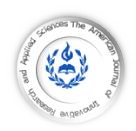

This article is made freely available as part of this journal's Open Access: | Sunday ManuscriptRef.3-AJIRAS140316 |

Affiliation:
1. University of Uyo | Department of Food Science & Technology | Uyo | Nigeria |
1. University of Uyo | Department of Food Science & Technology | Uyo | Nigeria |

Authors Copyright © 2015: | Sunday Ukwo | and | Anne Edima-Nyah |.
AUTHOR: Sanday Ukwo

American Journal of Innovative Research & Applied Sciences
Share us on Social Media Links:



| ISSN: 2429-5396 (e) | www.american-jiras.com | Copyright © 2016, ajiras, Atlantic Center for Research Sciences, All Rights Reserved |
| Web Site Form: v 0.1.05 | JF 22 Cours, Wellington le Clairval, Lillebonne | France |
| Web Site Form: v 0.1.05 | JF 22 Cours, Wellington le Clairval, Lillebonne | France |


ResearchBib, Google Scholar, SIS database, i.f.s.i.j, Scribd, IISJ, Eurasian Scientific Journal Index (ESJI), Indianscience.in, arastirmax, Directory of Research Journals Indexing, Pak Academic Sesearch, AcademicKeays, CiteSeerX, UDL Library, CAS Abstracts, J-Gate, WorldCat, Scirus, IET Inspec Direct, and getCited

American Journal of innovative
Research & Applied Sciences
Research & Applied Sciences
Indexed by:
ISSN 2429-5396 (Online)
| HOME || ABOUT US || ARCHIVES || AIMS AND SCOP || AUTHORS || REVIEW|| SUBMIT MANUSCRIPT || EDITORIAL BOARD || CONTACT US |
| HOME | ABOUT US | ARCHIVE | AIMS AND SCOP | AUTHORS | REVIEW | SUMIBMIT MANUSCRIPT | EDITORIAL BOARED | PUBLICATION FEE |
| | ARTICLES | Am. J. innov. res. appl. sci. Volume 2, Issue4 , Pages 193-197 (April 2016) |
| Research Article MICRONUTRIENTS AND HEAVY METALS CONTENT OF REFINED AND LOCAL TABLE SALTS CONSUMED IN SOME NIGERIAN CITIES | Sunday Ukwo | and | Anne Edima-Nyah |. American Journal of Innovative Research and Applied Sciences. 2016; 2(4):193-197. | PDF FULL TEXT | |Received | 14 March 2016| |Accepted | 30 March 2016| |Published 24 April 2016| |
ABSTRACT Background: Table salt is an essential food additive needed for flavoring, pickling and curing of foods in many households. These features have made salt an important part of human diet and culture. Salt is universal consumed by human in small fairly constant amount daily. It is therefore an ideal vehicle to deliver physiological amount of micronutrients as well as heavy metals into human body. Objectives: Thus, this study investigates physicochemical composition, micronutrients and heavy metals content of the refined and local table salts consumed in some Nigerian cities. Methods: This study was conducted in four Nigerian cities with history of local salt production. Four refined table salt samples A, B, C, and D were obtained from their major distributors while the other four samples E, F, G and H were local table salts obtained from local vendors. Samples were analysed for physicochemical composition, Micronutrients and heavy metals content. Results: The results of physic-chemical composition indicated a moisture content range of 0.35-0.43% for a refined table salt and 0.84 – 1.62% for the local table salt samples. There was no significant differences (P>0.05) in the pH and alkalinity in both the refined and local table salts while significant differences (P<0.05) existed in the percentage water insoluble matter between the refined and local table salts. Micronutrients analysis showed that Sodium chloride content ranged from 96.89-97.80% for the refined table salt and 95.42-96.42% for the local table salts. Iodine was not detected in the local table salts while Magnesium and Calcium were present in all samples analysed. Results of heavy metals analysis indicated elevated concentrations of Copper, Lead, Arsenic and Cadmium in the local salt samples and these were far above the limit stipulated by regulatory agencies. Conclusion: The continuous present and consumption of these local salts samples by the inhabitant of these areas is gross violation of food safety principles. Keywords: Food additive, Sodium Chloride, Regulatory Agencies, Nigeria. |
| April | VOLUME 1 | N° 4 | 2016 |